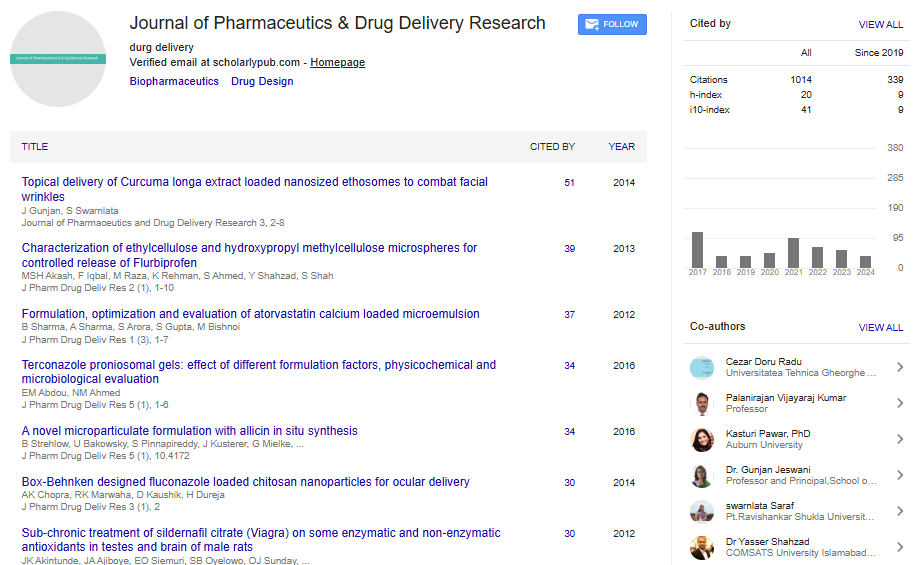Biological and micellar properties of nano transition metal (Co, Fe, Ni, Cu and Zn) complexes of 4-(1H-Imidazo[4,5-f][1,10]Phenanthroline-2-yl)-N,Ndimethylbenzene amine
Md Abdus Subhan, Rezwan Ahmed, Pallab Chandra Saha, Kulsuma Begum and Abul Kalam Azad
Shah Jalal University of Science and Technology, Bangladesh
: J Pharm Drug Deliv Res
Abstract
Novel ligand, 4-(1H-Imidazo[4,5-f][1,10]Phenanthroline-2-yl)-N,Ndimethylbenzene amine(L) (Scheme) was synthesized from 1,10-Phenantroline. Nano transition metal (Co, Fe, Ni, Cu and Zn) complexes of this ligand have been synthesized. Another metal complex of cobalt with (E)-2-styryl-1H-Imidazo[4,5-f][1,10]phenanthroline(L¢) ligand has also been synthesized and characterized. The ligand and the metal complexes were characterized by UV-Visible, FTIR, AFM and Mass Spectrometry. AFM study (scheme) showed that the average roughness of the [Co(L)2(Ac)2], [Fe(L)2(Ac)2], [Ni(L)2(Ac)2], [Cu(L)2(Ac)2], [Zn(L)2(Ac)2] and [Co(L')2(Ac)2] are 14, 10.9, 5.9, 73, 4.42 and 101.42 respectively. The particle size of the metal complexes [Co(L)2(Ac)2], [Fe(L)2(Ac)2], [Ni(L)2(Ac)2], [Cu(L)2(Ac)2], [Zn(L)2(Ac)2] and [Co(L')2(Ac)2] observed are 73.7, 184.6, 145, 222.45, 62 nm and 1.33 μm, respectively. DNA binding study of the synthesized metal complexes showed that the nano metal complexes are strong DNA binding and cleaving materials. The study of micellar behavior of SDS in presence of metal complexes in aqueous solutions was carried out by measuring the absorbance of 1-(2-pyridylazo)-2-naphthol (PAN) at 470 nm. The complexes [Co(L)2(Ac)2], [Fe(L)2(Ac)2], [Ni(L)2(Ac)2], [Cu(L)2(Ac)2], [Zn(L)2(Ac)2] and [Co(L')2(Ac)2] were found to decrease the CMC value of SDS. Negative values for ΔG°mic of SDS are observed for the metal complexes. Negative values of ΔG°mic indicated that the process of micellization is thermodynamically favorable. In this presentation, we will also discuss our recent work on trimetallic nanocomposite oxide particles and their medicinal applications.
Biography
Md Abdus Subhan received his PhD from Osaka University, Japan in March 2003. In 2004, he had been a Venture Business Laboratory (VBL) Post-doctoral Fellow at Materials and Life Science, Faculty of Engineering, Osaka University for a year. Then, he joined Shah Jalal University of Science and Technology, Sylhet, Bangladesh as faculty. In 2010, he visited Osaka Kyoiku University, Japan as Visiting Researcher to study the PL properties of mixed metal nano composite oxides. He had been National Research Foundation (NRF) Postdoctoral Fellow at Andong National University, Republic of Korea for a year (2010–2011), where he studied novel macrocyclic metal complexes. He had been BK21 Post-doctoral Fellow at Seoul National University, Republic of Korea for six months (2012–2013). At present, he is a Professor and Head of Department of Chemistry at Shah Jalal University of Science and Technology, Sylhet, Bangladesh. His major research field includes novel metal complexes of materials, medicinal and biological importance as well as structure, spectroscopy, catalysis and photocatalysis, anti-microbial activity of multi-metal nanocomposite oxides.
Email: subhan-che@sust.edu
 Spanish
Spanish  Chinese
Chinese  Russian
Russian  German
German  French
French  Japanese
Japanese  Portuguese
Portuguese  Hindi
Hindi 
